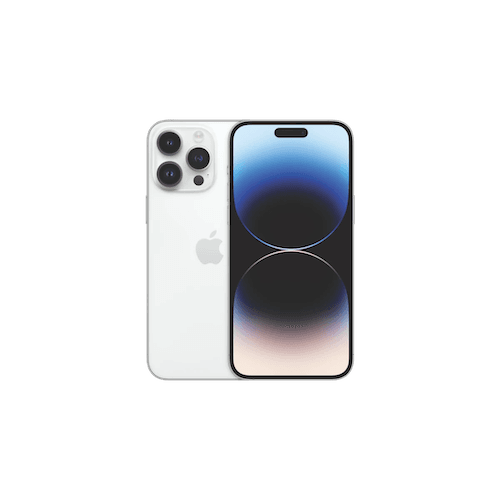Apple iPhone 14 Pro Max review: Bigger is only better some of the time
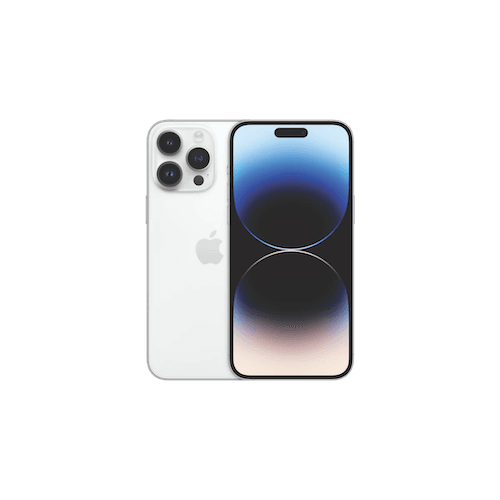
-
- Battery Score
- Camera Score
4.5
- Design Score
3.5
- Performance Score
5
- Battery Score
Summary
Quick verdict: The iPhone 14 Pro Max is a big phone with plenty of appeal to pro photographers, but it’s not your only choice this year if you prefer your iPhones on the hefty side.
- Best battery life in an iPhone yet
- A16 Bionic is the best smartphone processor, hands down
- Improved camera system delivers top-notch results
- It costs as much (or more) than a MacBook Air
- iPhone 14 Plus has a similar sized screen for less
- iPhone 14 Pro has the same cameras but is easier to hold and frame
Details
Pricing & Availability
| RRP | $0 |
| Launch date | 2022-09 |
For years now, if you wanted the biggest iPhone, you only had the choice of the Pro Max model. You got a big iPhone but you also got a big dent in your wallet.
That's not the iPhone story in 2022.
The iPhone 14 Pro Max is still a big and chunky iPhone, but it's not the only big and chunky iPhone. Before very long, you'll be able to buy the iPhone 14 Plus at a significant discount to the Pro Max's hefty price.
As it did last year, the Pro Max model doesn't have a camera or processor advantage over the cheaper iPhone 14 Pro, either.
All of this means that while the iPhone 14 Pro Max is Apple's most expensive iPhone, it's also got more internal competition than ever before. Whether it's worth it will very much depend not only on your budget, but also on specifically what you want out of a premium phone.
Design: The Dynamic Island seems smaller
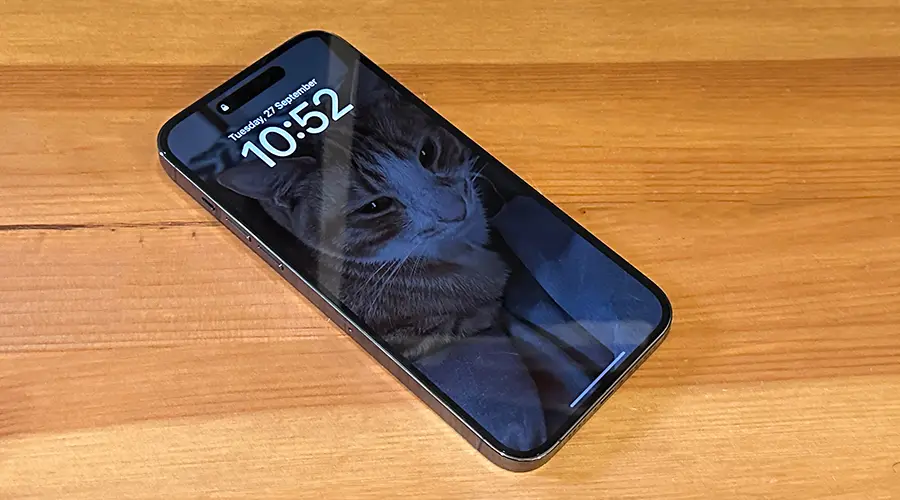
Image: Alex Kidman/Finder
Like its 2021 counterpart the iPhone 13 Pro Max, the iPhone 14 Pro Max is built around a 6.7-inch 2976x1290 pixel 460 ppi OLED display with 1–120Hz refresh rate capability, or in AppleSpeak, a "ProMotion" display.
Like any other Apple term, its marketing speak can mean anything it wants it to, but in this case it means it's a very nice, pin-sharp display. It's sharper than last year's display, in fact, which packed a 2778x1284 display into its frame.
Where are those extra pixels coming from? They're coming from the genuinely new design feature found only in Apple's Pro-grade iPhone 14 models this year, the "Dynamic Island".
That's the Apple term for its pill-shaped FaceID camera holepunch, considerably smaller than the full notch found on older iPhones or the cheaper iPhone 14 and iPhone 14 Plus models.
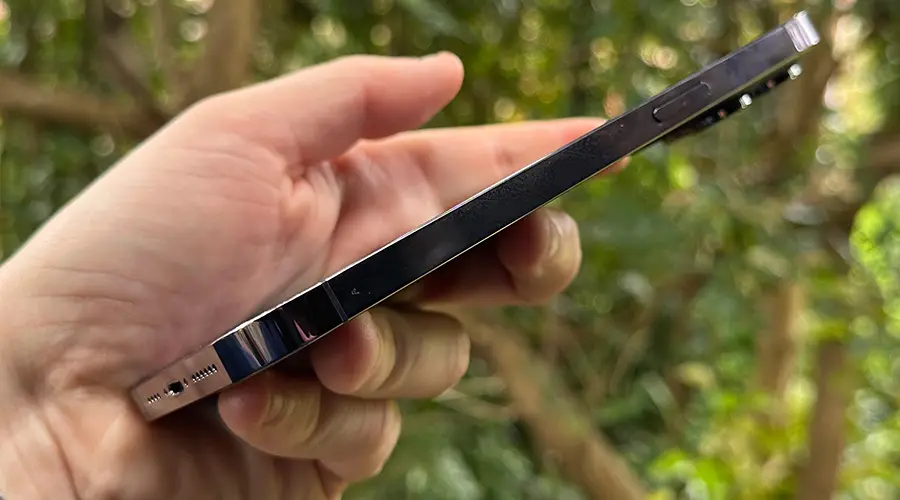
Image: Alex Kidman/Finder
Apple hasn't just gone for a slender notch design for the sake of it, either. There's some clever software trickery behind the Dynamic Island camera array.
Of course, you can still use it to unlock your phone or verify purchases with Apple Pay. However, when you do, or for a range of other features like timers or music playback, the area around the pill shape animates to show that activity.
It doesn't display over the top of the actual camera sections – this isn't a Galaxy Fold 4 under-display camera – but it can distract somewhat from the existence of the pill shape itself.
It's rather odd shifting from the iPhone 14 Pro to the iPhone 14 Pro Max, both of which share the same dynamic island pill shaped camera. On both, I found the animation around the dynamic display cute, but not something I'd buy a smartphone for, to be clear.
However, the larger size of the iPhone 14 Pro Max's display means that the dynamic island sits as a smaller overall element within the screen. This makes it just a little bit easier to look past most of the time, which is pleasing.
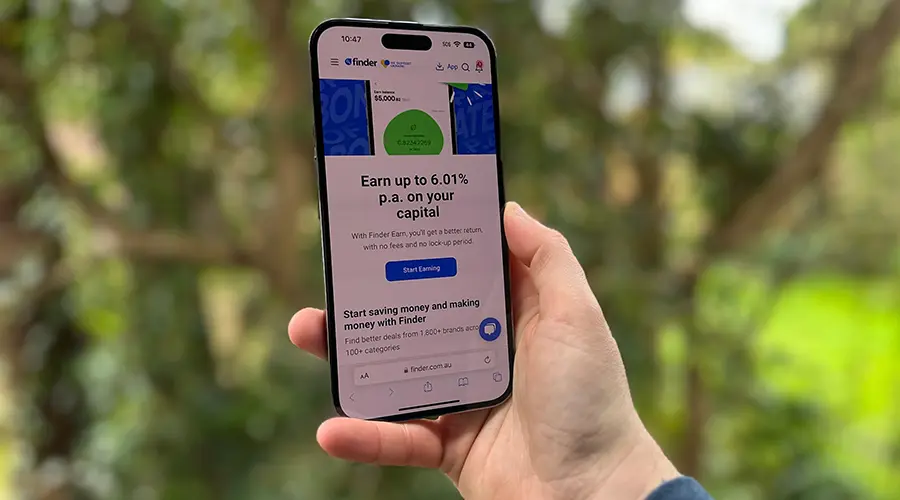
Image: Alex Kidman/Finder
The ProMotion display in the 2013 iPhone Pro models was largely just used to maximise battery life, but in 2022 Apple's added a new trick to its arsenal, although it's not a new trick for smartphones.
The iPhone 14 Pro Max has an always-on display feature that shows your wallpaper, the time and a small selection of widgets in a dimmed display, refreshing at just 1Hz.
The idea here is that you don't need a fast refresh rate for what is mostly a clock, so you can use a low rate and save a lot of battery power. Android phones have had this kind of feature for years now, although I can't recall one that used low refresh rates and a photo backdrop in this way.
Your colour choices for this year cover Space Black, Silver, Gold and Deep Purple. That Prince-themed hue is the new contender this year, and I was very much looking forward to getting used to a funky purple phone.
I was, to be honest, just a little disappointed. It's purple, for sure, but it's a more metallic hue, which does fit the "professional" tag of the phone, but feels less fun to me.
Then again, I'm boring enough to throw a case onto a phone that can easily cost more than $2,000. If I want to go crazy protecting my investment in an iPhone, I can do so with whatever colours I like.
At 160.7x77.6x7.85mm and 240g, the iPhone 14 Pro Max sure does live up to that "Max" suffix. This gives you the benefit of a larger display for movies, games and social doom scrolling, but it also means it's a degree harder to use single handed, the same as any other larger phone.
Camera: Great pro camera that’s harder to hold
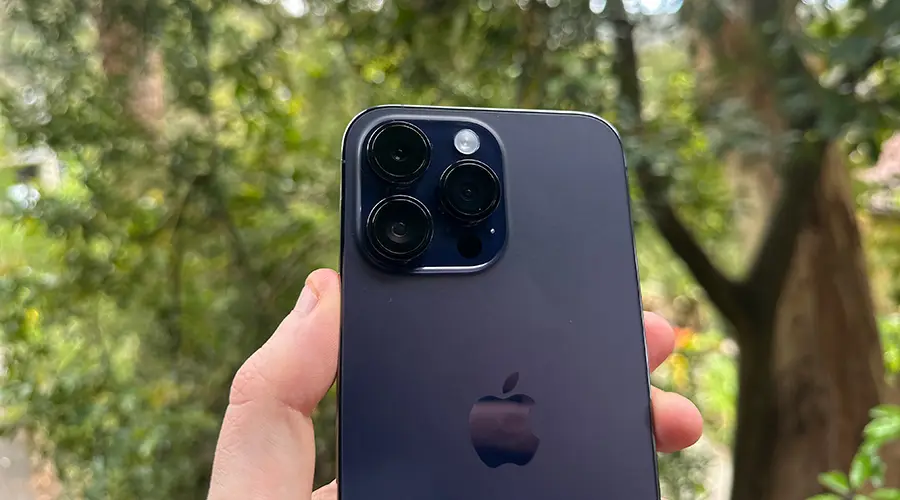
Image: Alex Kidman/Finder
The camera features on the Pro iPhones are Apple's primary pitch zone for why you might want to buy one; if you're just a point and shoot happy snapper, as per Apple, the regular phones are fine, but if you want or need more precise shooting, then you need a Pro phone.
However, the reality is that with the switch last year to the same camera array across the regular Pro and Pro Max models, that means it doesn't have to be the Pro Max in order to get the best camera results Apple can provide.
At a technical level there's a lot of change from last year's phones. While the ultrawide lens remains at 12MP, it's with a larger sensor that should aid in low light capture. The telephoto rear lens also remains at just 12MP and 3x optical, but there's also a new 2x optical mode that doesn't, strictly speaking, rely on the optical lens at all.
That's because of the new wide sensor, which trips the scales at 48MP, a new high for iPhone camera sensors. Good photography isn't just a matter of counting the megapixels, but having a higher count does allow for more technical trickery. That 2x optical zoom is actually a crop down from the 48MP sensor, where previously if you wanted less than the 3x zoom, you were using a lesser digital zoom approximation.
So how does that work in actual shooting situations?
Here's a shot of a local war memorial, taken at first from across the road using the ultrawide 12MP lens:
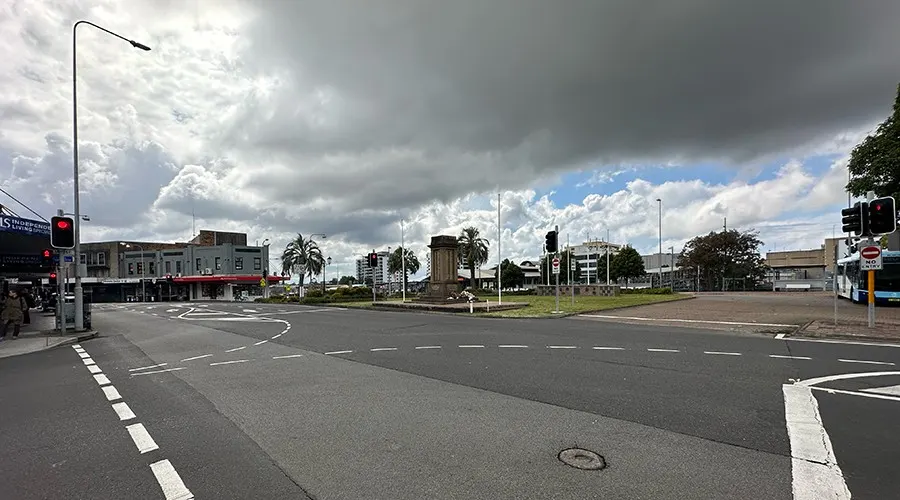
Image: Alex Kidman/Finder
The same shot with the wide lens turns out fine too, as you'd expect as this is the primary 48MP lens:
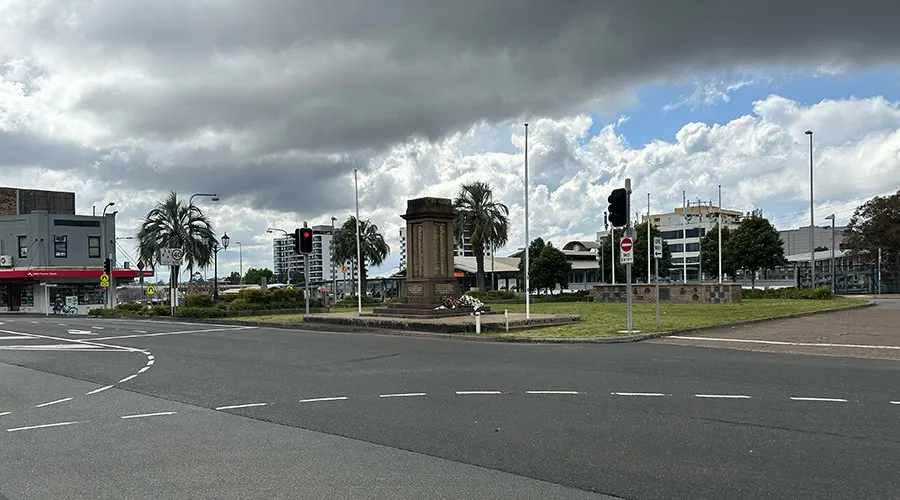
Image: Alex Kidman/Finder
2x zoom, a crop from that 48MP lens looks like this, still good:
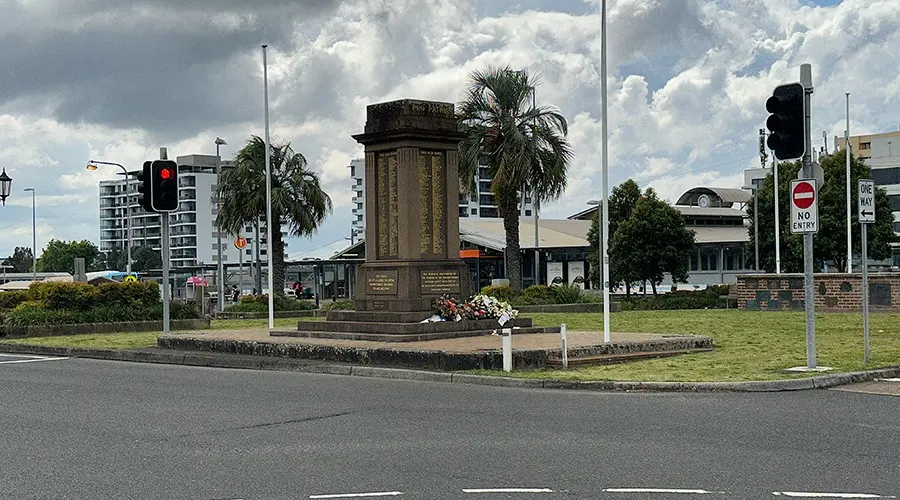
Image: Alex Kidman/Finder
And 3x zoom, optically stabilised is also at good quality, as you should absolutely expect:

Image: Alex Kidman/Finder
You can always zoom out further, but you're getting into total digital zoom territory and its limitations if you do so. The iPhone 14 Pro Max stops its telephoto attempts at 15x. That's way lower than (for example) the Samsung Galaxy S22 Ultra, but the results are still pleasing, showing how sometimes less is more:
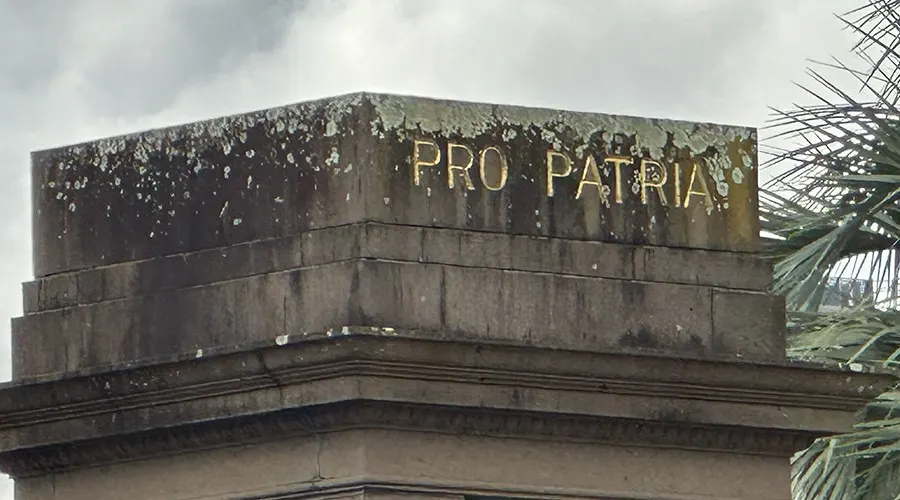
Image: Alex Kidman/Finder
By default, the 48MP primary lens actually shoots at 12MP, using familiar-to-Android-users pixel binning to raise sensor size and low light sensitivity.
Apple's low light game was already amongst the best in the business, and I was keen to see just how much difference the 48MP sensor might make to the iPhone 14 Pro Max's camera capabilities.
To test it in a comparative setting, I grabbed the iPhone 14 Pro Max, the iPhone 14 Pro and the dual lens iPhone 14 Pro, along with last year's iPhone 13 Pro Max and Google's competing Pixel 6 Pro and headed to a local park late one night for a little comparative shooting.
Here's a night silhouette shot of some trees at the park, a challenging balance choice for any phone. All shots were taken handheld, allowing each phone to pick focus, exposure time and in their relative night modes.
First up, last year's iPhone 13 Pro, which delivered a rather cold toned shot with some noise:
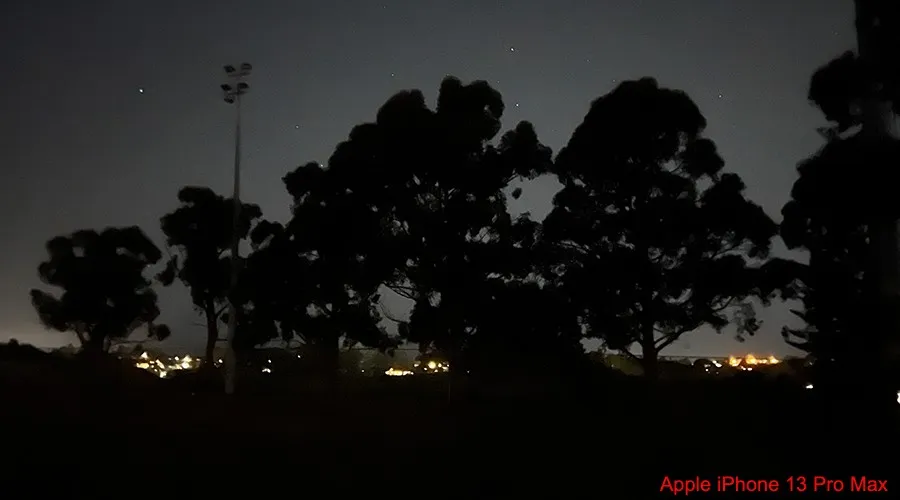
Image: Alex Kidman/Finder
Google's Pixel 6 Pro, one of my favourite Android low light performers, does a better colour job, still with some noise:
Image: Alex Kidman/Finder
The cheaper iPhone 14 does a fair job of it, but as you'd absolutely expect it's not quite at the pro level, with some focus and noise issues of its own:
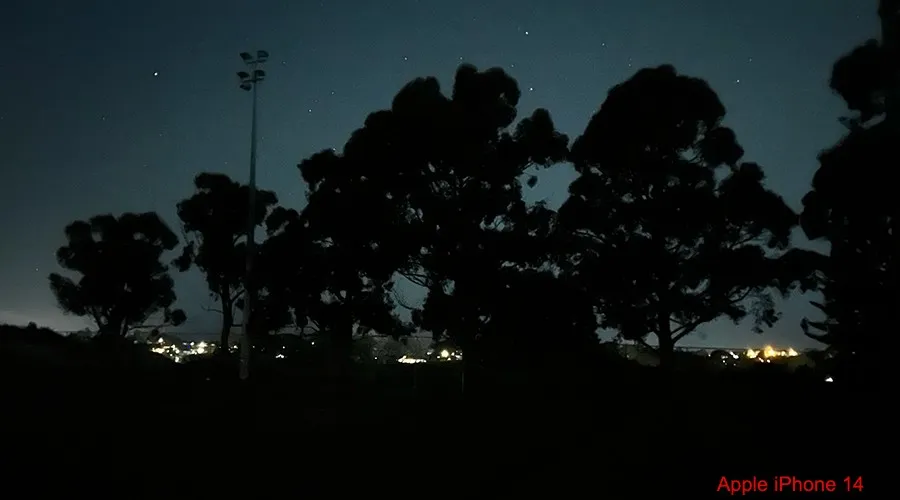
Image: Alex Kidman/Finder
The iPhone 14 Pro delivered a very pleasing shot overall given the conditions:
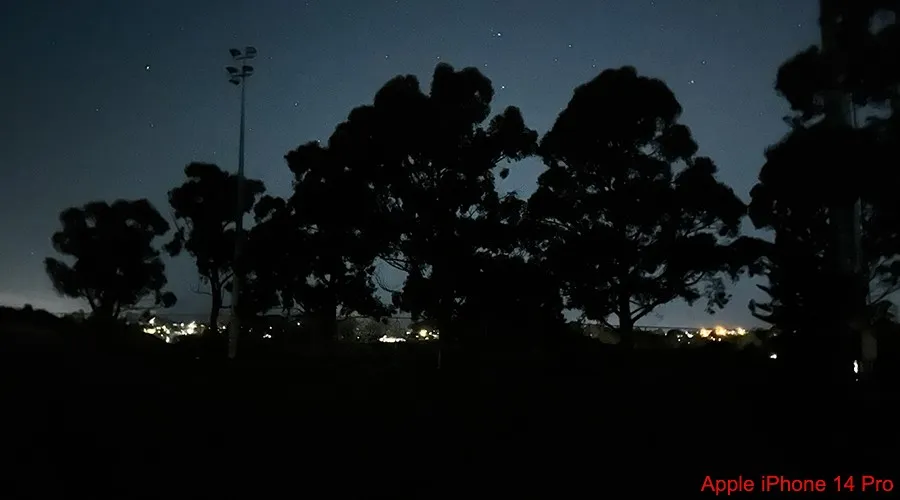
Image: Alex Kidman/Finder
And much the same shot came out of the iPhone 14 Pro Max, which is not surprising as it's got the exact same camera specifications:
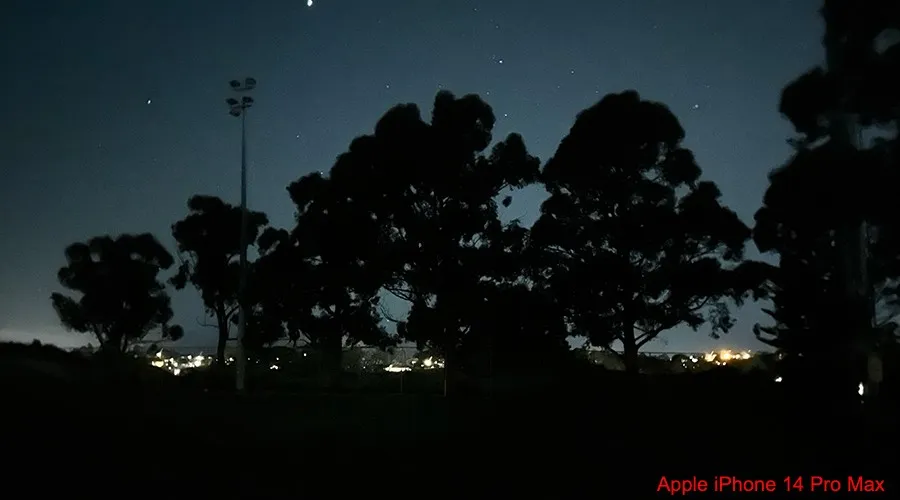
Image: Alex Kidman/Finder
It's in no way surprising that the iPhone 14 Pro and iPhone 14 Pro Max shoot near identically. Something would be radically wrong if they didn't.
However, it's not quite accurate to say that they shoot in the same way, because the larger size of the iPhone 14 Pro Max body does have an effect on the way you shoot. While you technically get a larger viewfinder on the Pro Max, the bigger challenge is that the iPhone 14 Pro Max is a bigger handset. That means it's a harder phone to hold steady for low light shots without a tripod, and a larger device to carry around for shooting purposes.
That's always going to be relative to your hand size, and there are some benefits in battery endurance that the iPhone 14 Pro Max brings to the table. Still, if I was choosing between the two, I'd opt for the more hand-friendly iPhone 14 Pro for my general shooting.
As one of Apple's pro phones there's also the possibility to shoot in full ProRAW mode for a lot of manual post-processing, not that Apple's new "Photonic Engine" pipeline doesn't do a generally pleasing job in most respects if you are more inclined to let the camera do the heavy lifting for you.
If you shoot video, upgrades here include the ability to shoot in full 4K in cinematic mode, as well as a new "action camera" mode that provides virtual gimbal stabilisation while shooting regular video. However, it is very fussy about light levels, constantly complaining at me when shooting that somehow I needed to turn the sun up. That's beyond my capabilities, Apple – and my neighbours would complain when their flowers wilted even if I could do it.
There's very little to fault the iPhone 14 Pro Max's cameras on in terms of output, although that jump to 48MP does come with a price if you want to shoot at full resolution. Not shockingly, 48MP images are very large, and iPhone storage capacities are (as always) set, with no capacity for any kind of expansion via storage card. That's the kind of feature that pro shooters expect with their DSLRs, Apple, so maybe consider adding it for next year's phones?
OK, that's very unlikely to happen, but I can dream, can't I?
Apple iPhone 14 Pro Max sample photos

Image: Alex Kidman/Finder

Image: Alex Kidman/Finder

Image: Alex Kidman/Finder

Image: Alex Kidman/Finder

Image: Alex Kidman/Finder

Image: Alex Kidman/Finder
Performance: A16 takes the performance crown – now it needs something to do with it
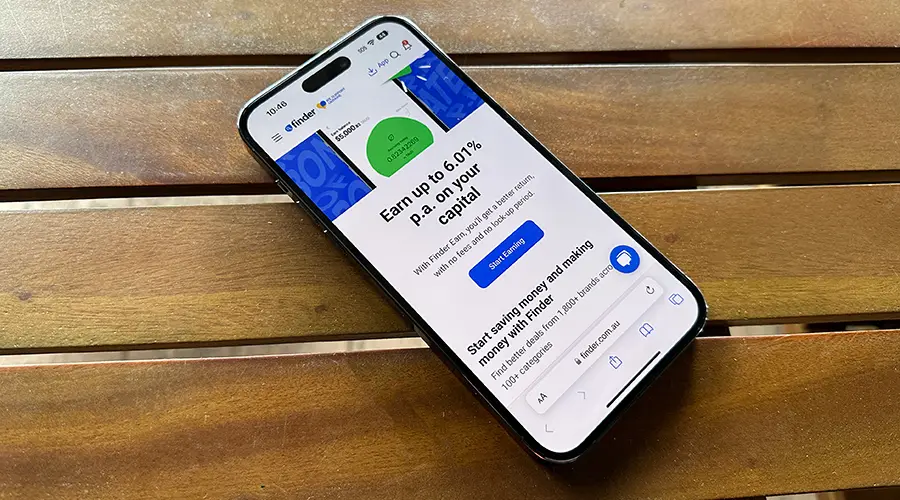
Image: Alex Kidman/Finder
The Apple iPhone 14 Pro Max runs on Apple's new A16 Bionic chip. In prior years, you'd see the same new chip across all of that year's iPhones, but for 2022 Apple's made a very deliberate performance decision.
The iPhone 14 and iPhone 14 Plus get last year's A15 Bionic – albeit the slightly more GPU-heavy variant found in the iPhone 13 Pro Max – but it's only in the Pro phones that you'll get Apple's newest and fastest chip.
Apple's lead in mobile processors over its largely Qualcomm-based Android competition only stretches further with the A16 Bionic, but as always power like that needs purpose. The jump over the A15 Bionic isn't that pronounced, and it's certainly not at a level where you'll notice it in daily app usage.
Where you will see that difference is if you're shifting from an older model iPhone. Here's how the A16 Bionic as found in the Apple iPhone 14 Pro Max compares against several iPhone generations, using Geekbench 5's CPU test:
It's interesting that the Pro Max loses out to the Pro in that benchmark, but again, you won't see that kind of difference in real world app usage. Where you would see a boost is if you're upgrading from, say, an iPhone 12 Pro Max or older handset up to the iPhone 14 Pro Max.
For those who love to see where Apple sits relative to its Android competition, here's how the same metric compares against premium Android handsets:
The A16 Bionic delivers the expected improvements to performance that you'd want given Apple's premium pricing, but I am struck by the same issue I encountered with last year's iPhone generation.
They're powered by very impressive engines, but as yet, there doesn't seem to be much in terms of apps or approaches that really tax them to a significant extent. As such, there's not much here to get excited about if you're an iPhone 13 Pro Max owner, because your phone is still well and truly fast enough, and then some.
The iPhone 14 Pro Max is 5G capable, and if you were in the US, you'd only be able to buy a model that supports eSIM capabilities. That's likely to come down the line for international models like the Australian variant I've tested with, but what sadly hasn't come our way this year is full 5G capability.
To be specific, the iPhone 14 Pro Max supports sub-6Ghz 5G for international models, where the US model is dual sub-6GHz and the faster mmWave 5G standard as well. Australia has mmWave networks, and Apple's general position in years past has been that we get lesser iPhones because mmWave hadn't rolled out yet.
That's no longer true, but in order to save itself a few pennies per iPhone, we get a lesser unit.
While many of Apple's Android competitors do the same thing, it's galling when discussing the most expensive standard smartphones on the market to realise that they could support faster 5G locally, but don't because Apple USA doesn't see a need to give it to us, in order simply to fatten its own bottom line. Boo, Apple. Do better.
The other new features in the iPhone 14 Pro Max are ones that, at the time of writing are impossible or infeasible to test.
The iPhone 14 Pro Max is satellite phone compatible, or at least compatible with Apple's new emergency SOS feature. The idea here is neat. If you're stuck 100% outside any kind of mobile tower coverage (where standard SOS calls are available even without a SIM), you can point your iPhone to the skies, find a satellite and poke out a simple emergency message to enable your rescue if things have gone badly wrong.
Australia is a big country and it's not hard to see how this could be a literal life saver in remote rural Australia.
The problem is that satellite SOS is available only in the US and Canada, and only then in November 2022.
There's no announced time frame of when we might see it down under as a service, only a note that at some point Apple will charge for the service coverage. The hardware is there in Australian smartphones, but presumably Apple has to ink a few service contracts with satellite providers to make it happen down under.
In theory, I could check out the other new feature of the iPhone 14 Pro. It's just that it would involve me hitting a tree at 60kph or better.
I do like to go that extra mile when it comes to phone reviews, but not when it involves serious risk of death. The new Crash Detection feature's designed to alert family and emergency services if its gyroscope and GPS reasonably suspect that you've had an accident. Fail to respond quickly enough and it'll get to saving your life as best it can.
A neat feature that has at least been tested elsewhere dropping off a motorbike, but not one that I can test without my insurance company almost certainly cancelling my coverage.
Battery: It… just… keeps… going…
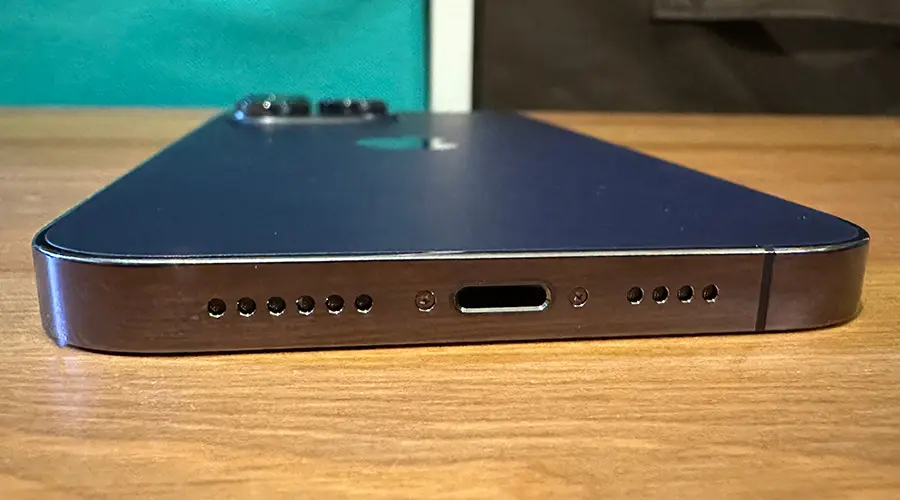
Image: Alex Kidman/Finder
The oldest joke in the smartphone book is the one about iPhone battery life, because for so very long, it was amongst the worst in the industry. When Apple switched up to larger iPhones it redressed that balance a lot, and recent Pro Max phones have been amongst the best smartphones for battery life, period.
Apple never officially releases battery capacities, but external sources suggest it's packing a 4,323mAh battery, marginally smaller than the battery in the iPhone 13 Pro Max. However, it clearly doesn't matter when it comes to real world battery life.
Apple (rather unhelpfully) has it as being good for up to 29 hours of video playback. That's about 2.5 times through the entire Lord Of The Rings Extended Editions if you do fancy a true movie marathon, but that's also not a useful metric in real world terms.
The iPhone 14 Pro Max has to balance the performance of the A16 Bionic and that always-on display, however. So how does it compare?
Very favourably. Extremely favourably, in fact, as demonstrated by Finder's battery test results:
That is, hands down, the best result I've ever hit with any iPhone of any generation. What I typically look for is above 90%, because phones that can't hit that mark struggle to last a single day.
Taking it back a generation, it's precisely the problem that the iPhone 13 Mini had.
Every percentage point above 90% is a big win, and the iPhone 14 Pro Max is a big winner. I've not been easily able to run it down without deliberately trying to do so in regular daily usage, and that's great news if you want an easy all-day iPhone… with a catch.
That catch is the iPhone 14 Plus, the similarly sized and presumably-similarly-battery-equipped variant launching on 7 October 2022. It's going to be really interesting to see how that phone compares on battery life. If it can equal the iPhone 14 Pro Max at a lower price point, it might become the better buy.
For recharging, Apple has stuck to its own Lightning connector yet again, though it's bumping very close to recent EU decisions that are likely to tip it towards USB C charging in future models.
It feels like a pity it didn't make that jump this year, as so much of the rest of the Apple world has already done. As with recent years, you don't get a charger in the box, just a Lightning cable that ends with USB C on the charging side. If wireless charging is your jam, MagSafe and standard Qi are supported at 15W and 7.5W respectively.
While I did hit some issues with heat build-up on the iPhone 14 Pro when wirelessly charging, I didn't have the same issues with the iPhone 14 Pro Max model. That may be a quirk of my specific models and testing set-up. It's worth keeping in mind that if you do hit a heat issue, your phone will stop charging. That's annoying in a power sense, but seriously preferable to having your phone catch fire.
Should you buy the Apple iPhone 14 Pro Max?
- Buy it if you want the biggest and boldest iPhone yet – and can afford it.
- Don't buy it if you just want a bigger display (at least until the iPhone 14 Plus is out).
For a long time, the iPhone Pro Max model of a given year had the very best of everything that Apple could offer. There's little doubting that the iPhone 14 Pro Max is a very impressive handset, with superb processing power, excellent cameras and battery life that just keeps on giving long after other iPhones have become dusty silicon bricks.
However, battery life aside, the level of competition it faces just within Apple makes it a tougher phone to recommend. The iPhone 14 Pro has the same performance and cameras in a much easier phone body to actually use and at a lower price point. The iPhone 14 Plus has the screen size if that's important to you, although you'd be giving up the always-on display and 120Hz refresh rates if you opted for that model.
Pricing and availability
The iPhone 14 Pro Max retails in Australia with pricing starting at $1,899 for a 128GB model, up to $2,769 for a 1TB model

Price
RRP: $1,369.00Where to buy

Specifications
Display
Camera
Physical Dimensions
Connectivity
Power, storage and battery
Device features
How we tested
The iPhone 14 Pro Max that I tested was loaned to me by Apple for the purposes of review. I tested it over a week, running the battery down on multiple days, with repeated benchmark and application testing, as well as in-depth camera testing to put it through its paces.
I have extensive testing experience with iPhones, having reviewed every single iPhone model ever released in Australia, alongside more than 2 decades of product reviewing across countless smartphones, mobile phones and other gadgets. I'm a multi-time Australian IT Journo award winner, including awards for best reviewer and best technical journalist.
Alex Finder
Senior editor
You are about to post a question on finder.com.au:
- Do not enter personal information (eg. surname, phone number, bank details) as your question will be made public
- finder.com.au is a financial comparison and information service, not a bank or product provider
- We cannot provide you with personal advice or recommendations
- Your answer might already be waiting – check previous questions below to see if yours has already been asked
Finder only provides general advice and factual information, so consider your own circumstances, or seek advice before you decide to act on our content. By submitting a question, you're accepting our Terms Of Service and Finder Group Privacy & Cookies Policy.
This site is protected by reCAPTCHA and the Privacy Policy and Terms of Service apply.

